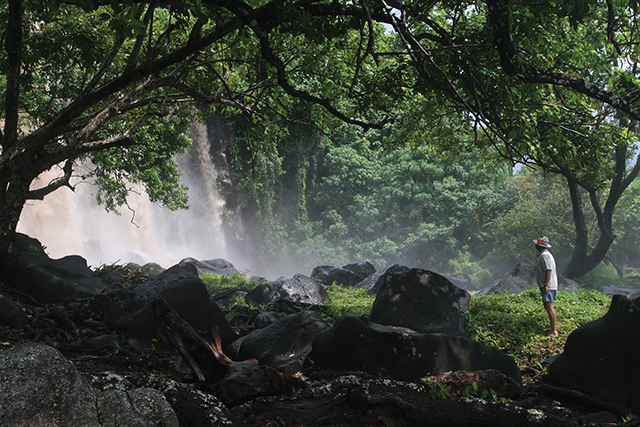Sasara Twin Waterfall Bay in Vanuatu’s Banks Islands (published September 2012)
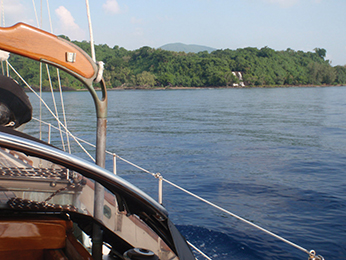
What most Americans know about Vanuatu was probably learned from watching a reality TV show. This is unfortunate, particularly for sailors, because we have a rare opportunity to visit this country’s remote anchorages and take a step back in time.
The Banks Island Group, which consists of 11 islands including the Reef Islands, is located in Vanuatu’s northern waters. The provincial headquarters in the village of Sola on Vanua Lava is the last port of entry/exit before sailing north to the Solomon Islands. Many yachts don’t allow enough time to visit the Banks Islands and skip the group altogether, clearing out at Luganville.
Dolphins leapt out of the water as we sailed from Sola around Mousoumes Point on the western side of the island and saw our first glimpse of the twin cascades that give Sasara Twin Waterfall Bay its name. We were struck by the beauty of this pristine, remote bay, where vertical, vine-covered rocky cliffs, dense jungle and ragged coastline blend perfectly together with the bird calls and waves lapping against the shore. The charcoal gray volcanic sand gave the water a vivid cobalt blue color, and dolphins were easily visible as we followed them into the bay. Schools of squid and various small fish used the boat as protection from larger predators, although not always successfully.
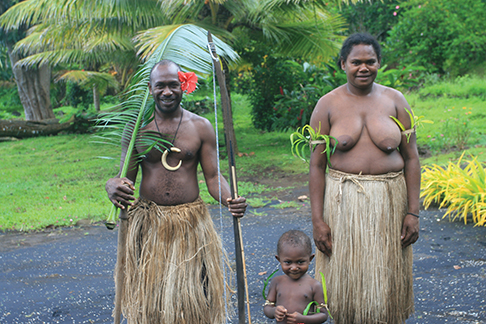
The small bay near the twin waterfalls provides a protected anchorage (13º49.51 South / 167º22.96 East) against the prevailing trades with very good holding. Chief Kerely Malau and his wife, Elizabeth, recognize the benefit of being able to provide services to visiting yachts, and the government of Vanuatu encourages villages located near anchorages to create “yacht clubs” in an effort to promote anchorages and facilitate visits. Over the course of the past 10 years, the Sasara Twin Waterfall Yacht Club building has gone from a simple thatched-roof shelter over a wooden bench with dirt floors to a traditional Long House bamboo structure with concrete flooring. By western standards, however, this is still a “yacht club” in name only. Chief Kerely intends his club to be a gathering place where cruisers can get information about guided hiking tours in the nearby jungle or up to the village plantation, as there are no maps of the footpaths through the dense, mountainous vegetation. It is also used for village gatherings and ceremonies.
When cruisers anchor outside a village in Vanuatu, it is customary for the captain to pay respects to the chief—a process that involves an introduction and brief discussion of areas that may be off limit to visitors. Such meetings are often perfunctory, so we were taken aback by the ceremony of Chief Kerely. He demonstrated the traditional ways his people greet visitors according to Kastom: his family sang a welcome song; a hibiscus flower was placed behind our left ears, symbolic of humanity’s brief time on earth; and he stressed the importance of getting to know each other so we can learn from one another. As he explained, there are no roads to his village, so anytime someone from another village walks through, he must greet them. Then, when it is his turn to walk through their village, they are not strangers. Visiting yachts are treated the same way. Chief Kerely wore his ceremonial tusk medallion over contemporary clothes to establish the importance of the occasion.
Chief Kerely is one of the two “paramount” chiefs on Vanua Lava. This enables him to work with the Parliamentary government of Vanuatu. He proudly maintains rich traditions passed down through the generations while integrating Christianity and modern technology whenever feasible. The paramount chiefs are re-establishing the old market economy where goods grown in the drier areas of the island, such as corn, are traded for produce grown where there is greater rainfall, such as wet taro. As chief, he is obligated to maintain a personal garden with ceremonial crops (such as kava) as well as subsistence crops to feed his family.
In the northern islands of Vanuatu, status is achieved by how much a chief can give away. Each family raises chickens and pigs, but the pigs are often slaughtered for a ceremonial feast, so much of their protein is garnered from the sea. He stressed the importance of keeping the “old ways” of plantation management and trading alive so the young people have the ability to survive without relying on modern foodstuffs bought in Sola, which is a half-day journey through the dense jungle—each way. Why, he asked in his soft-spoken manner, would you want to buy something when you can grow it yourself?
Nearly all of the anchorages in Vanuatu offer something in the way of snorkeling, fishing, hiking, beachcombing and swimming, and each is special in its own way. But Sasara Twin Waterfall Bay gave us a glimpse into traditional Ni-Vanuatu living and we were not surprised that Chief Kerely and Elizabeth’s concerns mirror those of leaders and parents throughout the U.S. and South Pacific. We were welcomed as family and thrilled when we discovered a small way we could pay them back for their hospitality. Chief Kerely’s village does not have any written record of births and marriages, so when he asked if we could make a copy of an old, blank family tree, we were pleased to create an updated one and print a couple dozen copies for his records. He designed a dual Certificate of Matrimony that incorporates civil information necessary for 21st century records, along with matrilineal and tribal information necessary to perpetuate their traditional records. He also suggested that he would appreciate having a photo of himself and his wife in traditional garb, if we wouldn’t mind taking one. Mind? We were flattered, and the photos speak for themselves. While this family may live in what Westerners consider to be primitive conditions, their society is rich in tradition and their lives diffused with ritual and symbolism.
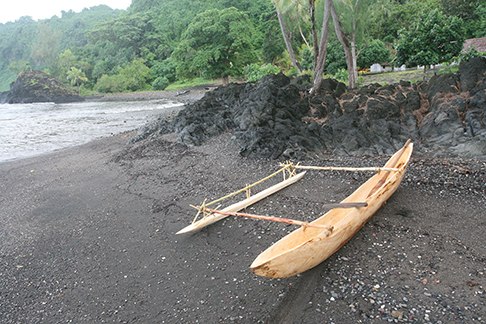
Other villagers paddled out in their dugout canoes to trade fresh produce for items often difficult to obtain. We traded fishing line and hooks, matches, D-batteries for flashlights (none of the homes have electricity), soap, pencils and t-shirts for pineapples, grapefruit, green onions and cherry tomatoes. It is important to note that—with the exception of the children, to whom the pencils were given for school—these people came to trade, not ask for handouts. What we would have liked to have been able to offer in trade were gently used children’s t-shirts, ladies t-shirts and tank tops, and small hand tools such as hammers, wood chisels, carpenters’ squares, etc., but we were unaware of the specific needs until we arrived.
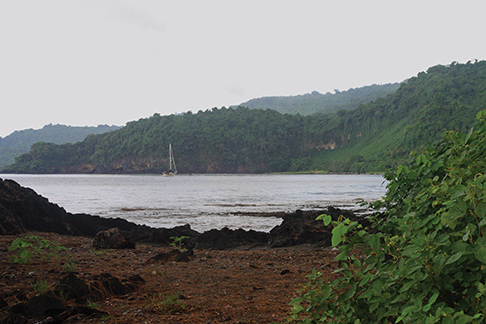
If you are looking for a glimpse of the “old” Vanuatu, you can find it at Sasara Twin Waterfall Bay. We would have loved to stay in this tranquil spot much longer (Chief Kerely offered to take us on walking tours of the village garden and nearby caves), but we had already stayed long beyond our permitted time. When a weather window opened up, we had to bid farewell to these fine people and move on.















